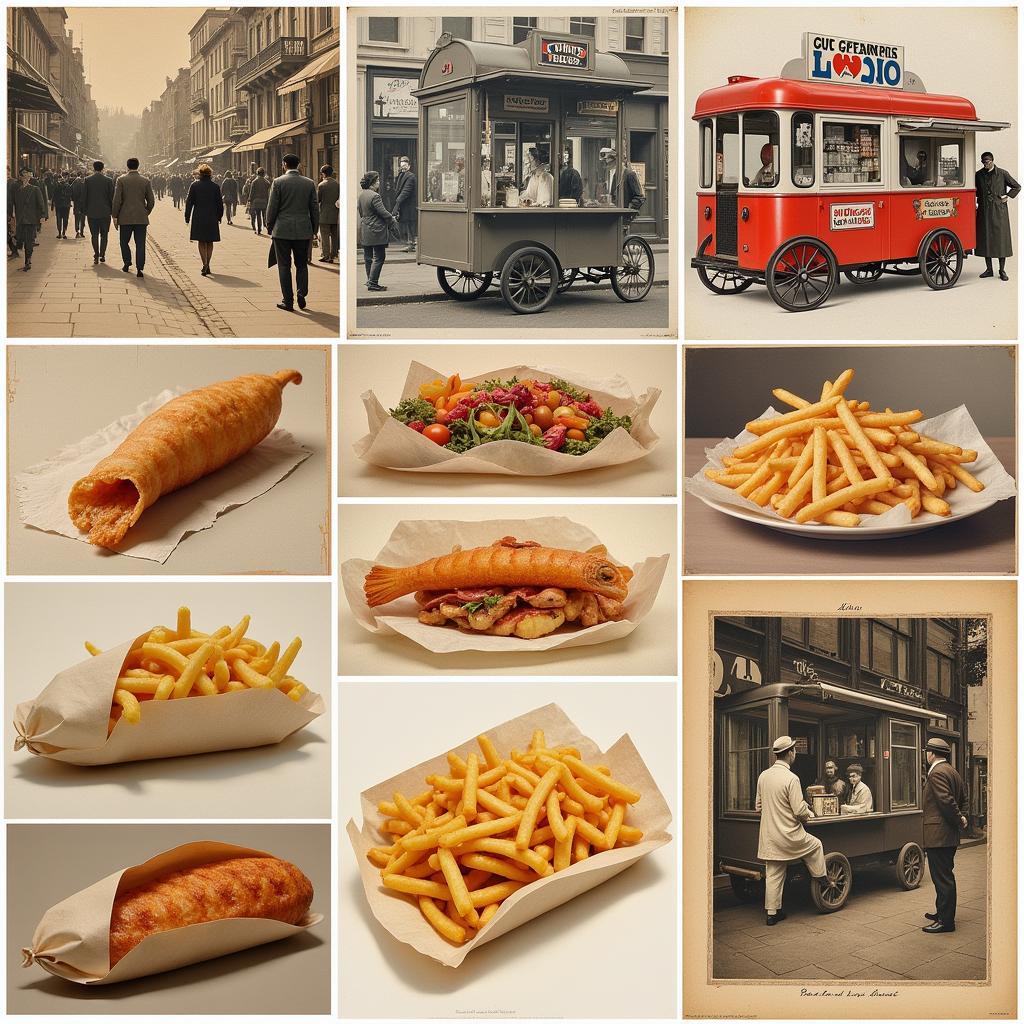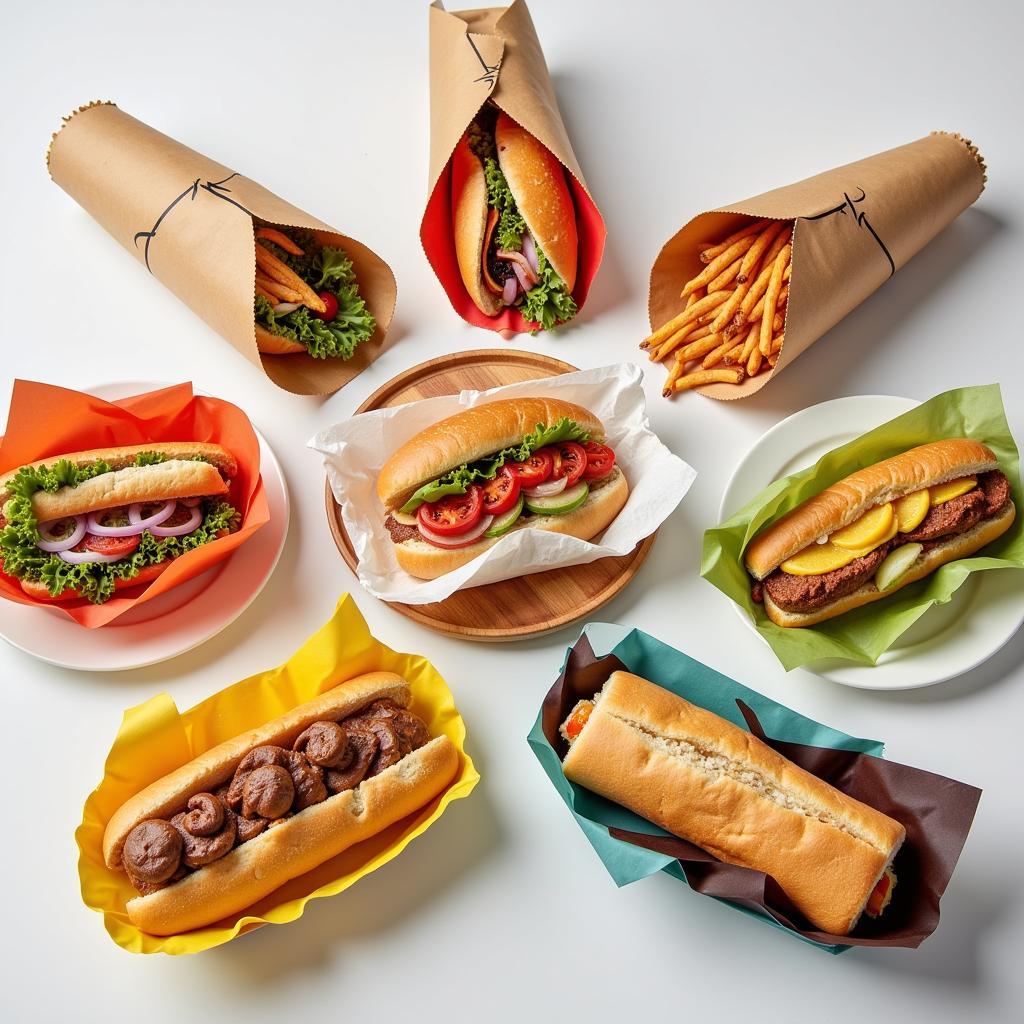Paper Wrap Food. It’s a concept as simple as it sounds, yet it evokes a sense of nostalgia, convenience, and perhaps a touch of greasy-spoon charm. From the humble fish and chips parcel to the iconic New York City street vendor halal, paper-wrapped food transcends cultures and continents, holding a special place in the hearts (and stomachs) of many.
But what exactly is it about this unassuming packaging that continues to captivate us? Let’s unwrap the reasons behind the enduring appeal of paper wrap food.
A History Wrapped in Tradition: More Than Just a Packaging Choice
 History of Paper Wrapped Food
History of Paper Wrapped Food
The use of paper to wrap food can be traced back centuries. Long before the advent of plastic and styrofoam, paper served as a readily available and biodegradable option. Think of it as the original “fast food” packaging, often used to transport meals on the go or for quick, casual bites.
For example, fish and chips, a beloved British staple, have been traditionally wrapped in paper since the 19th century. The paper, often newspaper in the early days, served to absorb excess grease and insulate the food, keeping it warm and crispy. This method became synonymous with the dish, adding to its charm and authenticity.
The Allure of Simplicity: Convenience at Your Fingertips
In a world of increasingly elaborate packaging, there’s a certain charm in the simplicity of paper wrap food. It’s quick, easy, and requires no utensils – perfect for a meal on the move or a casual picnic in the park.
Think about the quintessential street food experience: a steaming hot custom wax paper for food cone filled with spicy noodles, a juicy burger cradled in checkered paper, or a classic hot dog nestled in a soft bun. These experiences are defined by their no-frills approach, allowing you to savor the flavors without fuss or ceremony.
The Sustainability Factor: A Greener Way to Eat
In an era of heightened environmental awareness, paper wrap food offers a sustainable alternative to plastic containers and styrofoam boxes. Paper is biodegradable and recyclable, making it a more eco-friendly option that aligns with conscious consumption practices.
Many modern food vendors are opting for FSC food certified paper, ensuring that the paper they use comes from responsibly managed forests. This commitment to sustainability adds another layer of appeal for environmentally conscious consumers who want to enjoy their favorite foods without compromising their values.
Beyond Functionality: The Sensory Experience
The appeal of paper wrap food goes beyond mere practicality. It’s a sensory experience that engages sight, smell, and touch.
Visual Appeal: The way food is presented influences our perception of its taste and quality. The rustic charm of brown paper or the vibrant colors of printed wax paper instantly grab our attention.
Aromatic Anticipation: The aroma of freshly cooked food wafting through the paper is an invitation to indulge. It creates a sense of anticipation and heightens our enjoyment of the meal.
Tactile Pleasure: The feel of paper in our hands evokes a sense of familiarity and comfort. It’s a tactile experience that connects us to the food and enhances our enjoyment.
Paper Wrap Food Today: Innovation and Adaptation
 Contemporary Examples of Paper Wrap Food
Contemporary Examples of Paper Wrap Food
While paper wrap food might evoke a sense of nostalgia, it’s far from outdated. In fact, it’s experiencing a resurgence in popularity, fueled by growing trends like street food markets, food trucks, and a renewed appreciation for simplicity and sustainability.
Chefs and food vendors are finding innovative ways to elevate the paper wrap experience. Gourmet sandwiches are presented in gold food wrapping paper, adding a touch of elegance to a casual meal. Food trucks are experimenting with biodegradable paper cones and wraps, showcasing a diverse range of cuisines from around the world.
FAQs: Unwrapping Your Questions About Paper Wrap Food
1. Is paper wrap food safe?
Yes, paper wrap food is generally safe. Food-grade paper is treated to be grease-resistant and safe for contact with food. However, it’s always a good idea to check with the vendor to ensure they are using appropriate food-grade materials.
2. What types of food are best suited for paper wrap?
Paper wrap is ideal for food that is not overly saucy or wet, as it can lead to sogginess. Popular options include sandwiches, burgers, fries, wraps, and street food items like tacos and burritos.
3. Can I reheat food in paper wrap?
It’s not recommended to reheat food in paper wrap, especially in a microwave. The paper can catch fire, and the heat may not distribute evenly, resulting in unevenly cooked food.
Conclusion: A Timeless Classic with a Bright Future
Paper wrap food continues to hold a special place in our culinary landscape. It’s a testament to the enduring power of simplicity, convenience, and sustainability. As we move towards a more environmentally conscious future, expect to see even more creative and innovative uses of paper in the food industry.
Next time you’re craving a quick bite or a casual meal, consider opting for paper wrap food. You’ll be enjoying a timeless classic while making a conscious choice for the planet.
Need help navigating the world of pacific food and wine? Or want to explore sustainable packaging options like ice packs for food shipping? Contact us today! Our team is here to help you 24/7. Call us at 02437655121, email us at [email protected], or visit us at 3PGH+8R9, ĐT70A, thôn Trung, Bắc Từ Liêm, Hà Nội, Việt Nam.